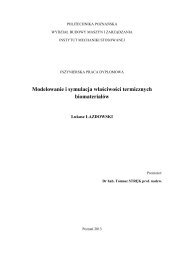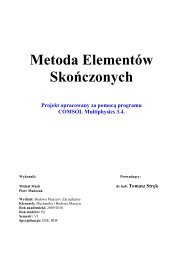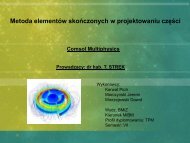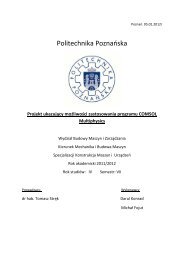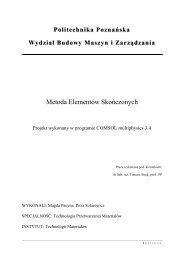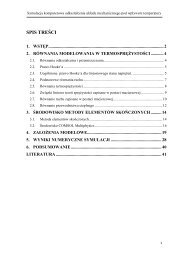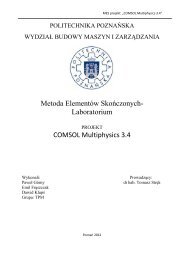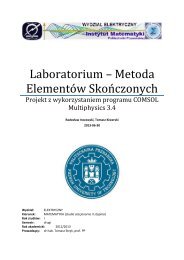Lithium-Ion Battery Simulation for Greener Ford Vehicles
Lithium-Ion Battery Simulation for Greener Ford Vehicles
Lithium-Ion Battery Simulation for Greener Ford Vehicles
You also want an ePaper? Increase the reach of your titles
YUMPU automatically turns print PDFs into web optimized ePapers that Google loves.
ENERGY<br />
ENEL, ROME, ITALY<br />
(Figure 1) within COMSOL<br />
Multiphysics and the results<br />
(Figure 2) were quickly validated<br />
by a physical investigation<br />
of thermography (Figure 3) and<br />
thermocouple measurements.<br />
“To begin, we undertook two<br />
kinds of simulation. Firstly we<br />
created a stationary model and<br />
used it to determine the level<br />
of heating power which needed<br />
to be applied by cable to ensure<br />
that the temperature in all<br />
areas of the drainage system<br />
remained above the point at<br />
which salt solidifies. We carried<br />
out a 3D solid-fluid conjugate<br />
heat transfer simulation<br />
where both the conic drain part<br />
and the surrounding air were<br />
modeled. We considered heat<br />
transfer by conduction in the<br />
<strong>for</strong>mer, while both conduction<br />
and convection were taken into<br />
account in the latter. All the<br />
material properties were temperature<br />
dependent. We simulated<br />
heat loss in the remaining<br />
part of the drain by using<br />
COMSOL’s built-in library of<br />
local heat transfer coefficients.<br />
Thanks to such coefficients we<br />
saved both computational time<br />
and resources without affecting<br />
the accuracy of the simulation.”<br />
The team then created a second, dynamic,<br />
model to study the transient heating of<br />
the drain and check the time required to<br />
achieve the desired temperature.<br />
Another example of COMSOL application<br />
in CSP plant analysis has been the<br />
development of a model of the storage<br />
system to assess how, after validation, it<br />
could be optimized <strong>for</strong> plants of a larger<br />
size. This may incorporate several thermal<br />
bridges which would have to be assessed<br />
in order to avoid the potential<br />
<strong>for</strong> significant and costly thermal power<br />
losses. Daniele Consoli explains how heat<br />
transfer was modeled, “We considered<br />
heat transfer by conduction along the<br />
thickness of the wall (steel, insulation, aluminium<br />
sheet) and the foundation of the<br />
tank. We took both conduction and convection<br />
into account <strong>for</strong> the fluid (molten<br />
Figure 2. COMSOL simulation of the conic shape drain (the temperature field<br />
expressed in °C is shown).<br />
Figure 3. IR Thermography of the conic shape drain.<br />
salt) and convection and radiation <strong>for</strong> the<br />
surrounding air outside the tank.”<br />
Reliable Process Operation<br />
Given the over 50 million Euro ENEL<br />
total investment in the Archimede project,<br />
it was not difficult <strong>for</strong> Daniele Consoli to<br />
propose a business case <strong>for</strong> COMSOL Multiphysics.<br />
“Being able to simulate plant operation<br />
related to design choices on critical<br />
components was extremely important. In<br />
the case of the drainage circuit, simulation<br />
may significantly reduce the risk of<br />
potential damage to the power plant and<br />
the consequent costs in case of failures.<br />
COMSOL Multiphysics represented an<br />
appropriate tool <strong>for</strong> those analyses.”<br />
From the operating and maintenance<br />
point of view the drain represents a single<br />
point of failure. “If it failed we would have<br />
“Being able to<br />
simulate plant<br />
operation related to<br />
design choices on<br />
critical components<br />
was extremely<br />
important.”<br />
to stop one branch of the plant<br />
from producing energy whilst<br />
we undertook a repair operation.<br />
Then we would need to<br />
follow complex procedures in<br />
order to reactivate the affected<br />
branch, a process that takes<br />
at least 2 working days. All<br />
this would result in the loss of<br />
tens of man-hours, significant<br />
operational income, and above<br />
all, clean energy. In addition,<br />
being aware of the thermal<br />
stresses that the drain and the<br />
whole plant are subjected to,<br />
we can schedule the preventive<br />
maintenance in a more effective<br />
way.”<br />
According to Daniele Consoli<br />
another way to have sized the<br />
heating cables would have been via an iterative<br />
process based on experience and on<br />
monitoring the effectiveness of incremental<br />
changes in an empirical way. “With<br />
COMSOL we quickly discovered the exact<br />
amount of thermal power required and<br />
then validated the results directly.”<br />
The Archimede project has attracted<br />
great interest from utility companies within<br />
Europe and around the globe. Daniele<br />
Consoli again, “We were building the first<br />
power plant in world to use this technology<br />
and we needed to get the first plant<br />
right and then go on to improve it. There<br />
are many potential opportunities <strong>for</strong> solar<br />
thermodynamic technology and the next<br />
Parabolic Trough CSP may be much larger.<br />
As the technical challenges may also be<br />
bigger we will continue to employ COM-<br />
SOL Multiphysics.” ■<br />
2 2 // C O M S O L N E W S 2 0 1 1<br />
➮<br />
Cov ToC + – A<br />
➭<br />
20-22 CN ENEL 2011.indd 22 5/13/11 1:08 PM



